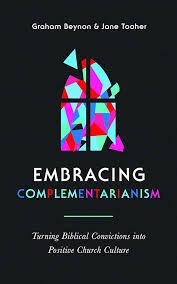Book review: Embracing Complementarianism
Hannah Yeo reviews “Embracing Complementarianism: Turning Biblical Convictions into Positive Church Culture” by Graham Beynon and Jane Tooher. Read it with other members to strengthen our unity and grow in maturity as Christ's body!
A Useful Little Book
“Embracing Complementarianism” is available for borrowing from our church library.
Embracing Complementarianism is the most useful book I have read on complementarianism. It is finger-thin, avoids straw-man arguments, and is co-authored by a man and a woman, practicing what it preaches.
The book looks at how complementarianism is understood and applied today. Its goal is for churches to embrace a positive view of complementarianism where members are convinced of God’s design, express it confidently, and live it out with joy.
Authors Graham Beynon and Jane Tooher argue that complementarianism exists as a spectrum. It arises because of different approaches to terms like “gender roles”, “teach or to assume authority over”, “ministry” and “church”.
The writers encourage church leaders to learn the reasons for these semantic differences and land on a position for their local church. Chapters 1–2 on gender roles and 6–7 on church and ministry are especially helpful, as are the four appendices including “Can Only Elders Preach?” and “Writing a Position Paper”.
Modelling Complementarianism
What excites me about Embracing Complementarianism is the spirit and tone with which it is written. Graham and Jane’s joyful collaboration models their message. They spend significant time laying a foundation of humility and understanding of contexts, neither jumping to cancel people nor binding consciences.
In their analysis of controversial texts, they hold space for multiple complementarian interpretations, explaining even those they would not agree with, for the sake of understanding how faithful Christians can land differently.
An acknowledgement and apology for misogyny is also graciously woven throughout the book, setting a godly example of confession, repentance and redemption. For example, Graham admits he had never considered what it might feel like for a woman to think that God loved her less than a man. He calls leaders to “recognise that it can be very hard for women to point [gender biases] out because they may feel that to do so would be seen to be criticising men or promoting themselves or will put them at risk of being labelled with a stereotype such as the difficult woman.”
Broad and Narrow View
The book shows how different positions among complementarians begin to appear right at Genesis 1–2, as people unpack gender differences to greater and lesser degrees. Whether you infer that in general, men are work-focused and more task oriented, while women are home-focused and more relational and nurturing, depends on whether you hold a broad or narrow view of gender roles.
The authors note how some Christian thinkers, like Carl Trueman and Aimee Byrd, point out that scripture only specifies gender roles for certain areas of life like marriage and church leadership. Hence, the narrow view would not extend limits or expectations for each gender to areas such as the secular workplace. The strength of the narrow view is it clearly works directly from scripture. Its weakness is it sees commands on gender roles as isolated islands that comment little on what it means to be men or women generally.
Others, like John Piper, hold a broad view and say that we are male and female across all of life, all the time, and therefore gender differences permeate everything. The strength of the broad view is it sees specific commands as the tip of an iceberg, the visibles parts of God’s broader design. Its weakness is its proponents make inferences about gender that Scripture does not.
As with many parts of the book, the authors emphasise that it is the role of church elders to decide how to land. The question then, for those who teach and preach, is to faithfully explain and apply Scripture to their respective church context.
Complementarianism and the Church
A discussion of ecclesiology and how it shapes complementarianism is one of the key strengths of this book. These discussions are often missing from conversations about men and women in the church. Instead, individualism haunts questions about gender roles in a certain way, “who am I, and what can I do?”, buying into the idea that our identity is achieved by expressing who we are.
In contrast, this book points out that our understanding of “church” and “ministry” is critical because ministry takes place in the context of churches. God’s plan of salvation is not merely to save individuals but to assemble (or “church”) a people who reflect him in the way they live together.
Take for example the passages in 1 Corinthians 11 and 14, which show that because gender matters, distinctions should be clearly seen. When men and women in the church look like their gender, they bring glory to God. The aim is good order in the church so that the entire church can be built up. In the same light, it is the pattern of headship, where Christ is the head and the church his bride, that makes maleness a qualification for the office of a church elder. In discussing 1 Timothy 2:11–14, the authors say that the “teaching” and “authority” Paul refers to go hand in hand. Teaching in a way that exercises authority within the church is reserved for elders (3:2). This means that church leaders must distinguish between contexts that require the authoritative teaching of the elders and those where mutual “one another” teaching takes place.
Equally Important, Working Together
Gender is deeply personal, and we all have history of some sort. While complementarianism can seem of secondary importance to the gospel message, its applications have affected people's relationship with the church and their faith as a whole.
So how can our local church collectively build a positive view and feel of complementarianism? Humility calls us to invite and listen to feedback on unconscious biases shaping our reactions. The authors highlight that it is especially important for leaders of complementarian churches to seek out and graciously listen to the perspectives of women in their church.
I am thankful that the number of women on our church staff has grown and our pastors and ministry leaders do invite them to speak into ministry plans and teaching preparation. I hope such opportunities will continue to expand. Including the perspectives of a plurality of teachers and counsellors among the many gifted women in our congregation will surely help us image God and glorify him more.
Ministry teams can do more to embody this kind of mutuality, regularly affirming both women and men as equally necessary parts. Do we expect contributions from both men and women, or does one gender’s views suffice by default? As a woman in a complementarian church, I need to steward the privilege of my gender and actively contribute to the building up of the whole body of Christ.. Recognising the historical tendency there has been to think of women as inferior, we as God’s people must also speak out against sexism or misogyny.
As in church life, so in gender—we are different but equally important and we need to work together for the gospel. May this positive vision help us love God's complementary design. As we live it out, may we reflect the glory of God and the good news of Christ to the world!
Interested to read this book? Borrow it from our church’s library! Head to the Fellowship Hall on Level 3 after service this Sunday to check it out.

